Britain prepares for conflict with Putin: Hundreds of army vehicles head to Poland to take part in NATO rehearsals for response to Russian threat
Hundreds of British army vehicles are heading to Poland as NATO forces carry out their biggest operation since the Cold War in preparation for a possible conflict with Russia.
In total, around 600 trucks were loaded onto two huge freighters at the Marchwood Sea Mounting Center near Southampton, bound for Eastern Europe.
About 1,500 troops will depart for Poland in the coming days as part of NATO’s Steadfast Defender exercise, which will be part of a force of 90,000 soldiers from the alliance conducting exercises until May.
The ‘unprecedented’ operation comes after it emerged that Vladimir Putin’s forces have lost more than 3,000 tanks during their illegal war in Ukraine – more than their entire pre-war inventory.
Although Russia is not explicitly mentioned in relation to the exercises, NATO considers the country to be the main direct threat to the security and peace of its members in Europe.
Hundreds of British army vehicles are heading to Poland as NATO forces stage their biggest operation since the Cold War
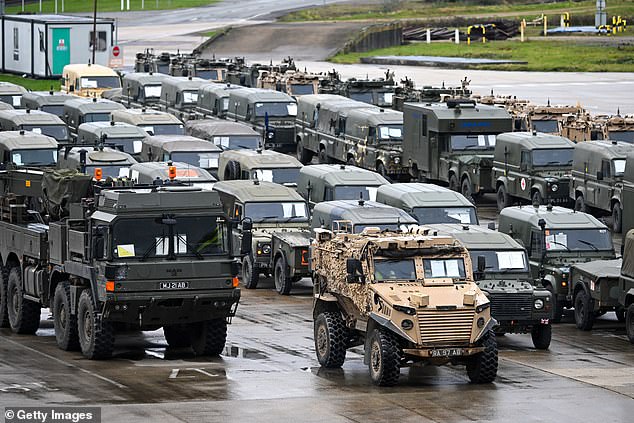
Military vehicles are loaded onto the ship Anvil Point at Sea Mounting Center on February 13

Marchwood’s operations officer said daily work at the port has escalated over the past two weeks

In total, around 600 trucks were loaded onto two huge freighters at the Marchwood Sea Mounting Center near Southampton, bound for Eastern Europe.
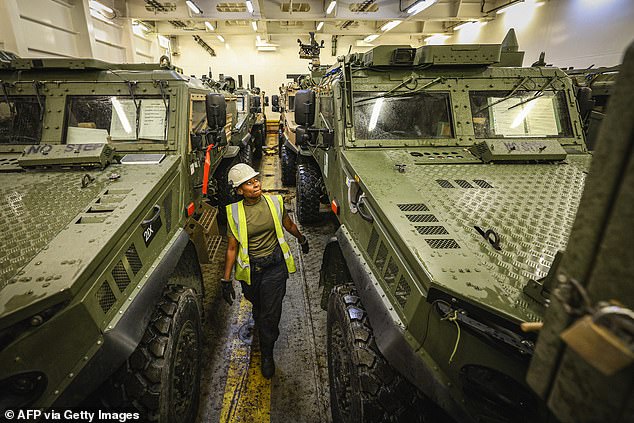
Work at the port has escalated and staff are now working 24 hours a day, in split shifts
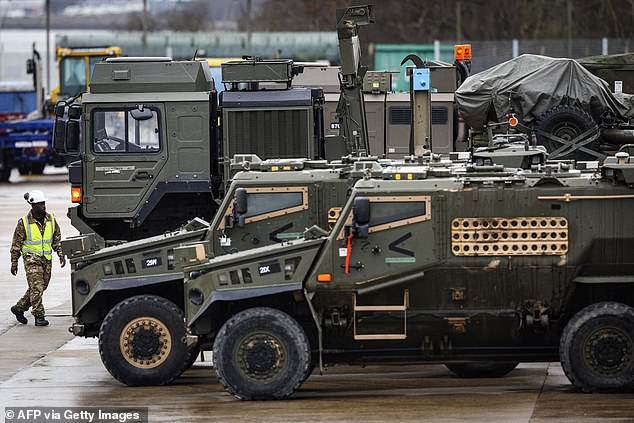
Foxhound armored vehicles belonging to the British Army’s 7 Light Mechanized Brigade unit are loaded by members of the Royal Logistics Corps
Photos show armored support vehicles rolling onto a 23,000-ton cargo ship as they prepare to sail to Germany before traveling on to Poland for the operation.
Vehicles from the 7 Light Mechanized Brigade, also known as ‘The Desert Rats’, alongside Land Rovers, engineer tractors and support vehicles were loaded yesterday for their journey from Anvil Point, near Southampton.
Captain Greg Jardine, 32, operations officer at Marchwood, said daily work at the port has escalated as a result over the past two weeks, with staff now working 24/7 in split shifts.
Captain Jardine, from Darlington, said: “It is an unprecedented format compared to our usual exercises.
‘It’s an escalation of pace in our training and that comes down to the practice.
“We are not in a situation where we expect to go to war anytime soon, but the situation in Europe has changed.”
The departure comes as HMS Prince of Wales, which leads the military maritime mission, set sail for the vicinity of Norway on Monday.
The British warship will be at the center of NATO exercises involving more than 20,000 British soldiers in Scandinavia and Northern Europe.
Corporal Lauren Drabble, 29, movement leader in Marchwood, said every vehicle had to be checked for explosives before being allowed on board the freighter.
She said: ‘We don’t normally receive this many vehicles, and this is certainly the largest operation I have been involved in in my career.’
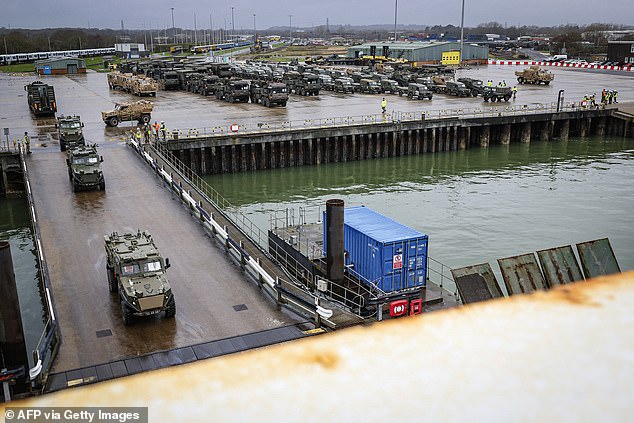
Armored vehicles roll onto a freighter to sail to Germany before traveling on to Poland for the operation
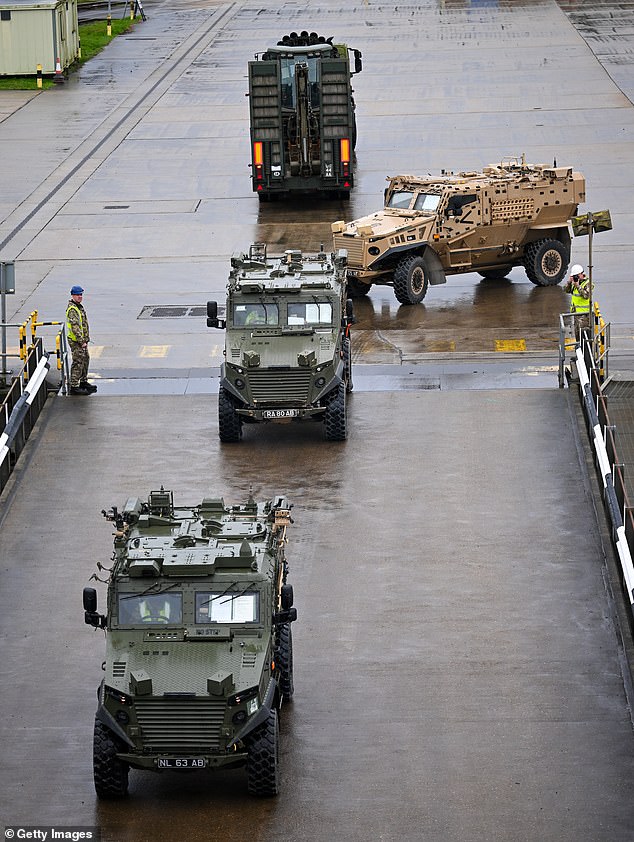
Land Rovers, engineers’ tractors and support vehicles were loaded yesterday for their journey from Anvil Point, near Southampton

The vehicles will take part in the months-long Steadfast Defender 24 exercise, intended to test the country’s defenses in light of Russia’s war against Ukraine.
It comes days after the German chancellor warned that Europe must ‘urgently’ increase ‘mass production of weapons’.
“This is urgently needed because the painful reality is that we are not living in times of peace,” he said, pointing to Russia’s war against Ukraine, adding: “Those who want peace must be able to successfully deter aggressors.”
His comments came as the Russian threat remains high to European states, which have called for increases in defense spending as Ukraine’s efforts to push back the invaders appear to be stalling.
The diplomatic push across the continent comes next Donald Trump, who is leading the race for the Republican nomination for the 2024 elections, said earlier this week that he did not believe European countries were paying enough money to NATO.
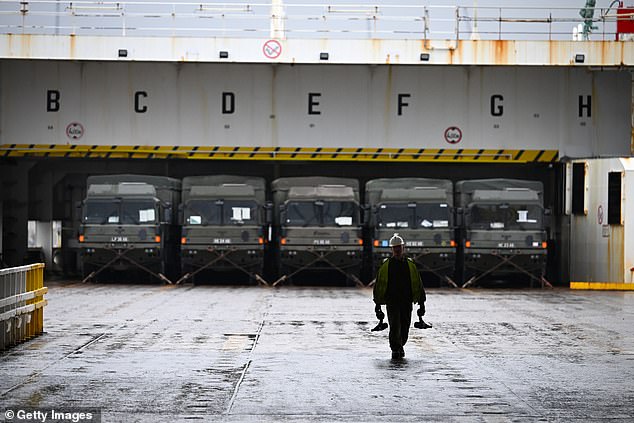
Photos show armored support vehicles rolling onto a 23,000-ton cargo ship as they prepare to sail to Germany
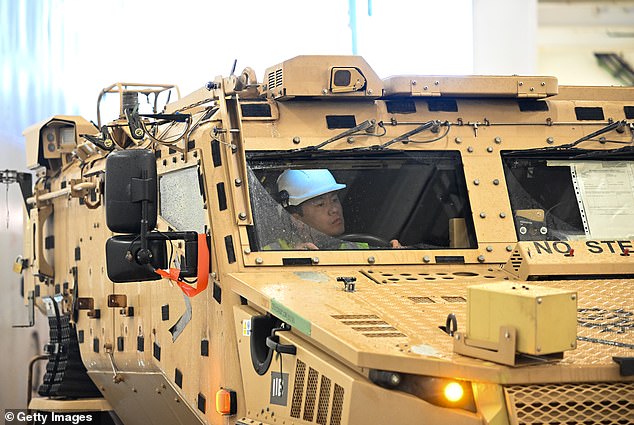
Armored vehicles from the 7 Light Mechanized Brigade, also known as ‘The Desert Rats’, were among the vehicles loaded for their journey from Anvil Point
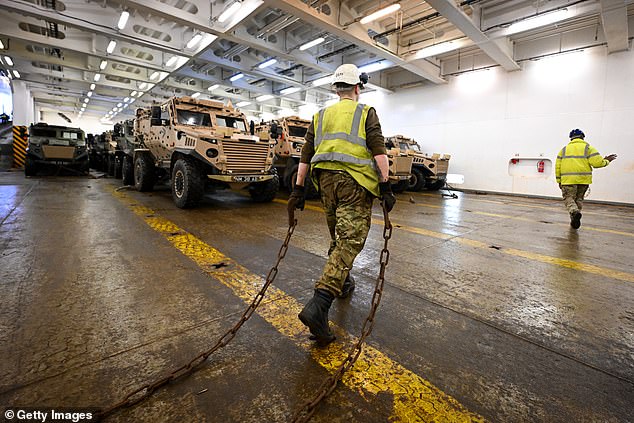
Military vehicles are loaded onto the ship Anvil Point at Sea Mounting Center in Marchwood on February 13, 2024
Speaking at a campaign rally in South Carolina on Saturday, the former president said he had told the leader of a “major” European power that he would not intervene if Russia attacked an ally that failed to meet its financial obligations.
‘No, I wouldn’t protect you. In fact, I would encourage them to do whatever they want,” Trump told his supporters.
President Joe Biden – who has pledged rock-solid support for the alliance – called his likely opponent’s comments in November’s presidential election “terrible and dangerous.”
NATO chief Jens Stoltenberg gave Trump an unusually strong rebuttal, saying: “Any suggestion that allies will not defend each other undermines all our security, including that of the US.”
The outburst was the Republican frontrunner’s most extreme and raised doubts among diplomats about his commitment to NATO’s collective defense umbrella, which has protected Europe since World War II.

The ‘unprecedented’ operation comes after it emerged that Vladimir Putin’s forces have lost more than 3,000 tanks during their illegal war in Ukraine.
A senior NATO diplomat, like others on condition of anonymity, called the comment an “attack on the soul of the alliance” as it cast doubt on the Article 5 pledge to protect an ally if attacked.
Moscow’s seizure of Crimea from Ukraine in 2014 has already prompted European countries to increase their defense budgets.
With the large-scale invasion in 2022, NATO changed the two percent spending obligation into a floor instead of a ceiling.
